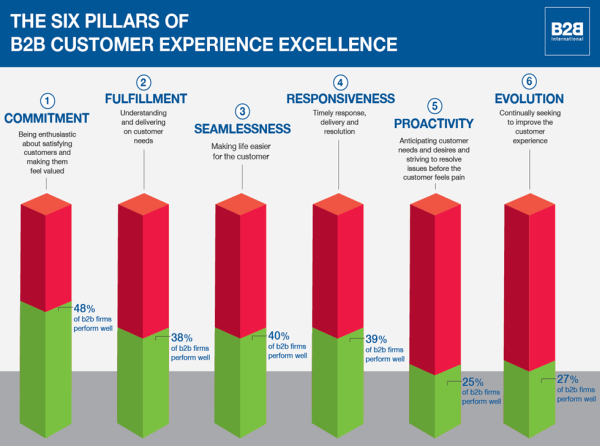The Chief Economist of the Bank of England, Andy Haldane, made the assertion last week that Britain’s productivity problems are caused by mediocre management. He wasn’t alone. Ann Francke, the chief executive of the Chartered Management Institute believes that in the UK, managerial skills are not taken seriously and are not valued.
The problem appears to be that Britain has 2.4 million “accidental” managers. These are people who are given a managerial role because they have skills in the job even though they have no aptitude or experience in managing people. The cost to the UK is estimated to be £20 billion per annum.
Now the reason we draw your attention to this seemingly sad state of affairs is that we recently carried out a survey amongst marketing professionals in the UK and the US. We asked 200 of them (they were all very large business to business firms) to what degree they believe their company performs well on 6 pillars of customer excellence. On most of the pillars of excellence, 60% of firms admitted that they are below par. This is one heck of an indictment! Surely 60% of these managers wouldn’t say that they are lousy drivers or bad husbands or wives.

We are not sure that the cause is as simple as Andy Haldane suggests. Could some of the problem be shackles and business processes that are holding managers back? In many large business to business companies marketing managers spend a good deal of their time in internecine fighting. Sales teams, credit controllers, production limitations may make it difficult for the hapless marketing teams to get things done. And getting things done is usually the most difficult thing of all. We are big fans of small steps. If you have enough of them you can get a long way.
Here are ten steps on the path towards better customer excellence.
-
Look after staff. Remember happy staff make happy customers. Do your staff know how much you appreciate them? How do you demonstrate this? How often do you do so?
-
Listen to customers and learn how they feel. How close are you to your customers? What are you hearing that you can change and that would make your products better?
-
Watch what customers do with your products and services. How are your customers using your products? Are they modifying them in any way? Could you make some improvements that would make their life easier?
-
Be nice, be friendly. A smile and a friendly comment goes a long way. People don’t want to speak to machines or disinterested service desks. How well do your customer facing staff engage with customers? How could training help?
-
Tell customers how important they are to you. Nothing frustrates a customer more than being told you can’t help them right now because you are busy with another customer. How often do you tell your customer how important they are to you and that they are the lifeblood of your business?
-
Make life easy for customers. Your customers are busy and if you can save them time they will love you for it. When did you last think about doing something that would make it easier for your customers to do business with you?
-
Manage expectations. In our eagerness to please we often promise more than we can deliver. What are your customer service and sales people promising customers? How could training improve the management of expectations?
-
Respond quickly. We live in a world where people expect to get answers the same day, even if it is just an acknowledgment that you are on their case. How quickly do you respond when a customer asks for something? What could you do to speed up responses?
-
Be generous in accepting blame. Are you defensive when things go wrong? Could you put things right without making a big issue and win the loyalty of the customer for your humility?
-
Give something unexpected. It is often the small unexpected things that a customer values and remembers. How often do you do something special and different for your customers?


